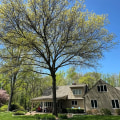Trees use sun, carbon dioxide, water and minerals to produce sugars. Sugars are the building blocks of tree growth. As a result, tree growth responds both to the environment and to the genetic makeup of trees. The trunk of a tree is essential for limb support and the transport of nutrients and moisture from root to leaf.
The trunk of the tree has to lengthen and expand as the tree grows in search of moisture and sunlight. The diameter growth of a tree is carried out through cell divisions in the cambium layer of the bark. Cambium is made up of cells from growth tissue and is located just below the cortex. Once a seed has landed and has been activated by environmental conditions, such as soil nutrients, water, temperature or fire, germination or water absorption and division begins.
After this, the first root, or taproot, makes its way to the ground, while the stem grows upward in the air, slowly lifting the seed box from the ground. Pretty quickly, the leaves start to grow and unfold, drinking CO2 and sunlight and eventually discarding the seed box. But the action not only occurs above the ground, below the surface, but the taproot thickens and deepens, sending small filaments that stick to the soil particles. Through this process, the tender seedling will turn into a hardy sapling with a single woody stem and leaves or needles in the form of a tree.
From there, the young tree will slowly transform into a mature tree with a deep taproot and thick lateral roots that hold the topsoil together while nourishing the rest of the tree. In some areas, such as rainforests, where the soil is shallow and poor, trees will grow aerial roots or reinforce roots above ground to absorb oxygen and provide additional stabilization. Most tree growth occurs in late spring and early summer. For most of the growing season, trees (plants) produce a material called chlorophyll.
Chlorophyll allows plants to convert water and carbon dioxide in the presence of sunlight into carbohydrates, which plants use as food. This process is known as photosynthesis. Chlorophyll is what gives plants their green color. The leaves of the trees have other colors present most of the time, but the green chlorophyll is so dominant that it masks the other colors until autumn.
While it may seem common sense, trees need water to grow. Providing your trees with adequate amounts of water can make a significant difference in helping them reach their full size at maturity. We recommend using a slow irrigation system to give tree roots the right amount of deep watering without drowning them. The trick is to make sure that the soil is moist but not soggy and that it has short periods of dryness between waterings to allow enough oxygen to penetrate.
Without enough water, trees will atrophy, and this will have the desired opposite effect. If you're not sure how much water your trees need, contact professionals, such as those at Mr. The tree increases every year in height and extension of the crown of the branches when the buds produce a new growth of twigs. Soils vary in the amount of nutrients available, so some trees have adapted to living in more sandy soils that are less nutrient-rich.
Trees eventually deteriorate and die due to bark damaged by insects, pathogens and environmental damage. Most trees spread or scatter their fruits around this time, planting seeds nearby for reproduction. And while it's true that obstacles can provide habitat for many species, entire ecosystems can collapse when too many trees are lost. We have served the Portland metropolitan area and all surrounding communities since 2000, with more than 30 years of experience in residential and commercial tree care.
As aspen and birch die, the next stage of the forest will be these trees, unless something happens (fire, windstorm or something else) that knocks down almost all the trees and opens that they are in full sun again where aspen and birch bloom. Developing a strong relationship with your tree service right from the start is a good idea, as your trees will continue to need care, including pruning and maintenance, if you want them to stay healthy for years to come. To make the most of the available moisture, the roots of the trees are shallow, with the exception of the main anchor root. The inner bark or phloem carries synthesized food from the leaves to the cambium layer and other growing parts of the tree.
This concept is important to you as an owner, especially if you are interested in specific trees. It can be the same tree, a new tree or another tree of a different species, but all trees originate from seeds. These stresses affect the tree making it more susceptible to insects and diseases, and eventually succumbs to a causative agent or competing pressures from other plants adjacent to the tree that grow more vigorously. .
.






